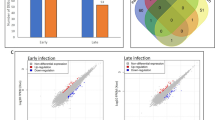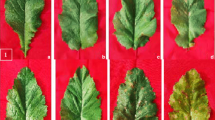Abstract
Transcript profiling of hsr203J, a known marker gene for Hypersensitive response (HR), was performed to delineate its role in differential defense against Alternaria brassicae in tolerant and susceptible genotypes of Brassica juncea. Reverse transcriptase (RT) PCR approach was utilized to investigate the correlation between expression of hsr203J like gene(s) and pathogenesis in stage dependent manner. It was revealed that the expression of hsr203J like gene increased as disease progressed from initial too late stage of infection in tolerant genotype. However, in susceptible genotype, its expression increased up to middle stage of infection with no expression in late stage of infection. In both genotypes, no expression of hsr203J like gene was observed in healthy leaves. It was observed that whereas three homologues of hsr203J like gene express at the late stage of infection in tolerant genotype, only single homologue of same expresses in susceptible genotype throughout all stages of infection. This indicates the role of hsr203J homologues in determining the differential defense response against Alternaria blight in Brassica. Determination of specific activity and in-gel assay revealed differential accumulation of protease and protease inhibitor in tolerant and susceptible genotypes at different stages of infection. Induction of differential protease and protease inhibitor activity appears to modulate the cell death during HR response to pathogen. Dissection of pathway leading to HR related cell death will enable us to know the molecular basis of disease resistance which will, in turn, help in engineering Brassica for resistance to Alternaria blight.




Similar content being viewed by others
Abbreviations
- HR:
-
Hypersensitive response
- RT:
-
Reverse transcriptase
- PCD:
-
Programmed cell death
- PR:
-
Pathogenesis related
- PDA:
-
Potato dextrose agar
- DAS:
-
Days after sowing
References
Bezier A, Lambert B, Ballieul F (2002) Cloning of a grapevine botrytis-responsive gene that has homology to the tobacco hypersensitivity-related hsr203J. J Exp Bot 53(378):2279–2280
Cai XZ, Zhou X, Xu YP, Joosten MH, de Wit PJ (2007) Cladosporium fulvum CfHNNI1 induces hypersensitive necrosis, defence gene expression and disease resistance in both host and nonhost plants. Plant Mol Biol 64(1–2):89–101
Cao H, Li H, Dong X (1998) Generation of broad-spectrum disease resistance by over expression of an essential regulatory gene in systemic acquired resistance. Proc Natl Sci U S A 95:6531–6536
Chacon O, Hernandez I, Portieles R, Lopez Y, Pujol M, Borras Hidalgo O (2009) Identification of defense related genes in tobacco responding to black shank disease. Plant Sci 177:175–180
Che FS, Iwano M, Tanaka N, Takayama S, Minami E, Shibuya N (1999) Biochemical and morphological features of rice cell death induced by Pseudomonas avenae. Plant Cell Physiol 40:1036–1045
Chichkova NV, Kim SH, Titova ES, Kalkum M, Morozov VS, Rubtsov YP, Kalinina NO, Taliansky ME, Vartapetian AB (2004) A plant caspase-like protease activated during the hypersensitive response. Plant Cell 16:157–171
Conn KL, Tewari JP, Awasthi RP (1990) A disease assessment key for Alternaria black spot in rapeseed and mustard. Can Plant Dis Survey 70:19–22
Dangl JL, Jones JDG (2001) Plant pathogens and integrated defence responses to infection. Nature 411:826–833
Gilroy EM, Hein I, Hoorn RV (2007) Involvement of cathepsin B in the plant disease resistance hypersensitive response. Plant J 52:1–13
Govrin E, Levine A (2000) The hypersensitive response facilitates plant infection by the necrotrophic pathogen botrytis cineria. Curr Biol 10:751–757
Graham MY (2005) The diphenylether herbicide lactofen induces cell death and expression of defense-related genes in soybean. Plant Physiol 139:1784–1794
Hamada H, Takevchi S, Kiba A, Tsuda S, Suzuki K, Hikichi Y, Okuno T (2005) Timing and extent of hypersensitive response are critical to restrict local and systemic spread of Pepper mild mottle virus in pepper containing the L3 gene. J Gen Plant Pathol 71:90–94
Hwang IS, Hwa BK (2011) The pepper mannose-binding lectin gene cambl1 is required to regulate cell death and defense responses to microbial pathogens. Plant Physiol 155:447–463
Jongsma MA, Bakker PL, Peters J, Bosch D, Stiekema WJ (1995) Adaptation of spodoptera exigua larvae to plant proteinase inhibitors by induction of gut proteinase activity insensitive to inhibition. Proc Natl Acad Sci 92:8041–8045
Kumar A, Sopory SK (2008) Signaling components in programmed cell death in recent advances in biotechnology and it’s applications. I.K. international Pvt. Ltd, New Delhi, p 694
Lowry OH, Rosebrough NJ, Farr AL, Rondall RJ (1951) Protein measurement with the folin-phenol reagent. J Biol Chem 193:265–275
Mishra A, Pandey D, Goel A, Kumar A (2010) Molecular cloning and in silico analysis of functional homologues of hypersensitive response gene(s) induced during pathogenesis of Alternaria blight in two genotypes of Brassica. J Proteomics Bioinform 3:244–248
Mur LA, Kenton P, Lloyd AJ, Ougham H, Prats E (2008) The hypersensitive response; the centenary is upon us but how much do we know? J Exp Bot 59:501–520
Nakaba S, Kubo T, Funada R (2011) Nuclear DNA fragmentation during cell death of short-lived ray tracheids in the conifer pinus densiflora. J Plant Res 124(3):379–384
Oh CS, Pedley KF, Martin GB (2010) Tomato 14-3-3 protein 7 positively regulates immunity-associated programmed cell death by enhancing protein abundance and signaling ability of MAPKKK α. Plant Cell 22(1):260–272
Oliveira AS, Filho JX (2003) Sales MP cysteine proteinases and cystatins. Braz Arch Biol Technol 46:91–104
Pandolfil V, Jorge EC, Melo CMR, Albuquerque ACS, Carrer H (2010) Gene expression profile of the plant pathogen Fusarium graminearum under the antagonistic effect of Pantoea agglomerans. Genet Mol Res 9(3):1298–1311
Petitot AS, Barbier S, Blein JP, Etienne P, Houot V, Suty L (2001) Hydrogen peroxide induces programmed cell death features in cultured tobacco BY2 cells, in a dose dependent manner. J Exp Bot 52(361):1721–1730
Pontier D, Godiard L, Marco Y, Roby D (1994) HSR 203J, a tobacco gene whose activation is rapid, highly localized and specific for incompatible plant pathogen interaction. Plant J 5:507–521
Pontier D, Tronchet M, Rogowsky P, Lam E, Roby D (1998) Activation of hsr203J, a plant gene expressed during incompatible plant pathogen interaction, is correlated with programmed cell death. Mol Plant Microbe Interact 11:544–554
Pontier D, Gan S, Amasino RM, Roby D, Lam E (1999) Markers for hypersensitive response and senescence show distinct patterns of expression. Plant Mol Biol 39:1243–1255
Pontier D, Balague C, Bezombes-Marion I, Tronchet M, Deslandes L, Roby D (2001) Identification of a novel pathogen-responsive element in the promoter of the tobacco gene HSR203J, a molecular marker of the hypersensitive response. Plant J 26(5):495–507
Ram RS, Chauhan VB (1998) Assessment of yield loss due to Alternaria leaf spot in various cultivars of mustard and rapeseed. J Mycopathol Res 36(2):109–111
Solomon M, Belenghi B, Delledonne M, Levine A (1999) The involvement of cysteine proteases and protease inhibitor genes in programmed cell death in plants. Plant Cell 11:431–444
Taga Y, Takai R, Kaneda T, Matsui H, Isogai A, Che FS (2009) Role of OsHSP90 and IREN, Ca2+ dependent nuclease, in plant hypersensitive cell death induced by transcription factor OsNAC4. Plant Signaling Behavior 4(8):740–742
Takahashi Y, Uehara Y, Berberich T, Ito A, Saitoh H, Miyazaki A, Terauchi R, Kusano T (2004) A subset of hypersensitive response marker genes, including HSR203J, is the downstream target of a spermine signal transduction pathway in tobacco. Plant J 40(4):586–595
Untergasser A, Nijveen H, Rao X, Bisseling T, Geurts R et al (2007) Primer3Plus, an enhanced web interface to Primer3. Nucleic Acids Res 35:W71–W74
Wang XLiu, Wei C, Xianming T, Chunlei D, Yanling M, Jinbiao H, Xueling W, Guorong H, Qingmei H, Kang Z (2010) Differential gene expression in incompatible interaction between wheat and stripe rust fungus revealed by cDNA-AFLP and comparison to compatible interaction. BMC Plant Biol 10:1471–2229
Xiao S, Dai L, Liu F, Wang Z, Peng W, Xie D (2004) COS1: an arabidopsis coronative insensitive 1 suppressor essential for regulation of jasmonate mediated plant defense and senescence. Plant Cell 16:1132–1142
Zhang H, Dong S, Wang M, Wang W, Song W, Dou X, Zheng X, Zhang Z (2010) The role of vacuolar processing enzyme (VPE) from Nicotiana benthamiana in the elicitor-triggered hypersensitive response and stomatal closure. J Exp Bot 61(13):3799–3812
Acknowledgement
The authors wish to acknowledge the Department of Science and Technology, Govt. of India for providing financial support under fast track scheme to the author Dinesh Pandey vide grant number SR/FT/L-58/2005. The support by Director, Experiment station, G. B. Pant University of Agriculture and Technology, Pantnagar is duly acknowledged.
Author information
Authors and Affiliations
Corresponding author
Rights and permissions
About this article
Cite this article
Mishra, A., Pandey, D., Singh, M. et al. Involvement of hsr203J like gene homologue, protease and protease inhibitors in triggering differential defense response against Alternaria blight in Brassica. Australasian Plant Pathol. 40, 461–470 (2011). https://doi.org/10.1007/s13313-011-0072-8
Received:
Accepted:
Published:
Issue Date:
DOI: https://doi.org/10.1007/s13313-011-0072-8




